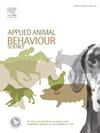巴西圣卡塔琳娜Florianópolis两个不同地区鸽子(Columba livia)的行为和福利
IF 2.2
2区 农林科学
Q1 AGRICULTURE, DAIRY & ANIMAL SCIENCE
引用次数: 0
摘要
鸽子在城市环境中是多产的动物,在城市中占据着独特的位置。居住在不同特征地点的群体之间的行为差异尚未完全了解,这可能有助于调查与鸽子福利有关的挑战。本研究的目的是调查居住在巴西圣卡塔琳娜Florianópolis两个地点的两个鸽子群的行为和福利:市中心和圣卡塔琳娜联邦大学(UFSC)校园。我们假设鸽子群在基本行为和福利方面的差异取决于它们所占据的位置。在冬季和春季分三个时段(06:00-10:00 h, 10:00-14:00 h, 14:00-18:00 h)进行观察,采用分组扫描抽样方法,每隔15分钟进行一次。此外,在研究地点对显示足部和脚趾受伤的鸽子进行了计数。鸽子在市中心表现出更高的患病率在寻求和探索行为(p = 0.011)和警报和恐惧(p = 0.012),而该集团生活在UFSC显示更高的患病率在维护行为(p = 0.005),侵略性和支配(p = 0.004),和生殖和父母的行为(p & lt; 0.001)。在市中心,平均有9.7只鸽子出现足部问题(SD = +4.6;最小= 4.0;最大值= 19.0)。相比之下,在UFSC校区,只有两只鸽子的脚或脚趾上缠着线或绳子,并伴有这些部位的损伤。位置是观察到的组间行为差异的预测器,证实了我们最初的假设。鸽子一直表现出寻找和探索的行为,同时减少了维护行为,特别是在市中心,这可能表明人们担心它们的福利。由于存在显著差异,了解鸽子在特定城市地点的行为有助于整合这些动物如何在城市中占据和空间分布的知识。我们的研究结果与现有种群管理策略的技术和伦理评估相关,支持考虑鸽子行为和福利的决策过程,并有助于促进城市地区鸽子与人类之间更和谐的共存。本文章由计算机程序翻译,如有差异,请以英文原文为准。
Behaviour and welfare of pigeons (Columba livia) in two different localities of Florianópolis, Santa Catarina, Brazil
Pigeons are prolific animals in urban contexts, occupying locations with distinct characteristics within a city. Behavioural variations among groups inhabiting locations with different characteristics are not yet fully understood and may serve to investigate challenges related to the welfare of pigeons. The aim of this study is to investigate the behaviour and welfare of two pigeon groups inhabiting two locations in Florianópolis, Santa Catarina, Brazil: the city centre and the campus of the Federal University of Santa Catarina (UFSC). We hypothesized that pigeon groups differ in fundamental behavioural and welfare aspects depending on the locations they occupy. Observations were conducted during winter and spring across three sessions (06:00–10:00 h, 10:00–14:00 h, 14:00–18:00 h), using the group scanning sampling method at regular 15-minute intervals. Additionally, counts of pigeons exhibiting foot and toe injuries were conducted in the study locations. The pigeons in the city centre exhibited higher prevalence rates in seeking and exploration behaviours (p = 0.011) and alert and fear (p = 0.012), whereas the group living at UFSC showed higher prevalence rates in maintenance behaviours (p = 0.005), aggressiveness and dominance (p = 0.004), and reproductive and parental behaviours (p < 0.001). In the city centre, a mean of 9.7 pigeons exhibiting foot problems was recorded (SD = +4.6; minimum = 4.0; maximum = 19.0). In contrast, at the UFSC campus, only two pigeons were identified with threads or strings entangled around their feet or toes, accompanied by injuries in these areas. The location is a predictor of the behavioural differences observed between the groups, confirming our initial hypotheses. The pigeons consistently displayed behaviours of seeking and exploration, alongside reduced maintenance behaviours, particularly in the city centre, and this may indicate a cause for concern regarding their welfare. Because there are significant differences, understanding how pigeons behave in specific urban locations contributes to incorporating knowledge on how these animals occupy and are spatially distributed across cities. Our results are relevant for the technical and ethical assessment of existing population management strategies, supporting decision-making processes that consider pigeon behaviour and welfare, and contribute to fostering a more harmonious coexistence between pigeons and humans in urban areas.
求助全文
通过发布文献求助,成功后即可免费获取论文全文。
去求助
来源期刊

Applied Animal Behaviour Science
农林科学-行为科学
CiteScore
4.40
自引率
21.70%
发文量
191
审稿时长
18.1 weeks
期刊介绍:
This journal publishes relevant information on the behaviour of domesticated and utilized animals.
Topics covered include:
-Behaviour of farm, zoo and laboratory animals in relation to animal management and welfare
-Behaviour of companion animals in relation to behavioural problems, for example, in relation to the training of dogs for different purposes, in relation to behavioural problems
-Studies of the behaviour of wild animals when these studies are relevant from an applied perspective, for example in relation to wildlife management, pest management or nature conservation
-Methodological studies within relevant fields
The principal subjects are farm, companion and laboratory animals, including, of course, poultry. The journal also deals with the following animal subjects:
-Those involved in any farming system, e.g. deer, rabbits and fur-bearing animals
-Those in ANY form of confinement, e.g. zoos, safari parks and other forms of display
-Feral animals, and any animal species which impinge on farming operations, e.g. as causes of loss or damage
-Species used for hunting, recreation etc. may also be considered as acceptable subjects in some instances
-Laboratory animals, if the material relates to their behavioural requirements
 求助内容:
求助内容: 应助结果提醒方式:
应助结果提醒方式:


